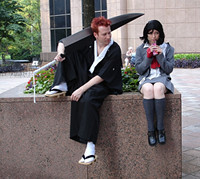Sometimes, as State-side Hobotaku, we all have some trouble figuring out the different ratings and designations for manga and anime - that's where this handy Hobotaku Dictionary can help. Now you'll know what it means when a manga said to be Shonen Yuri or a character typically Moe.
Kodomo (Target Audience: All kids)
Distinguishing Features: Child-friendly plots that may be moralistic, and marked lack of fan service.
Examples: Hamtaro, Doraemon
Shōnen (Target Audience: Males under 18)
Distinguishing Features: High action and humor
Examples: Bleach, Naruto
Shōjo (Target Audience: Females 13 - 18)
Distinguishing Features: Character development through realistic human relationships
(Note: Viz Media is re-defining Shōjo for their line of manga to mean having a male and female teenagers target audience)
Examples: Lala, Hana no Yume
Seinen (Target Audience: Males 18 - 30)
Distinguishing Features: Encompasses a variety of styles - can be strange, avant-garde and/or pornographic
Examples: Ai Yori Aoshi, Maison Ikkoku, Akira)
Josei (Target Audience: Females 18 - 30)
Distinguishing Features: Realistic characters who grow through realistic romance, sometimes with older characters and adult situations
Examples: Paradise Kiss, Nana, Gokusen
Shonen ai
Distinguishing Features: Never sexually explicit, focuses on homosexual relationships between male characters
Examples: Eerie Queerie, Little Butterfly, I Shall Never Return
Yaoi
Distinguishing Features: Sexually explicit, focuses on homosexual relationships between male characters
Examples: Bonds of Love, Lies & Kisses
Shoujo ai
Distinguishing Features: Not sexually explicit, focuses on homosexual relationships between female characters
Examples: .hack, Kashimashi
Yuri (technically, at this point, Shoujo ai and Yuri are interchangeable)
Distinguishing Features: Can be sexually explicit, focuses on homosexual relationships between female characters
Examples: Strawberry Panic, Burst Angel
Hentai (Target Audience: Over 18)
Distinguishing Features: Extreme sexual activity, including bondage, creatures with tentacles, or other fetishes
Examples: Cream Lemon, Bastard!!
Other Terms
Moe (pronounced "mo-eh")
A character with personality or appearance designed to elicit a protective or loving response from the audience.
Example: Tohru in Fruits Basket, Suiseiseki in Rozen Maiden
Bishonen (Sometimes called "Bishi")
Literally "beautiful youth" - a young male whose youth and sexual appear transcend the boundaries of gender
Example: Yuki Sohma in Fruits Basket, D'Eon in Chevalier D'Eon
Dojinshi
Self-published comics, largely they are of licensed works and feature sexually explicit material.
Lolicon
Japanese term for "Lolita complex" - term for sexual attraction of either gender to girls below the age of consent - childlike female characters are over-sexualized.
Shotacon
Japanese term for sexual complex where in an adult of either sex is attracted to an underage boy (to some extent FLCL and Negima have shotacon elements where older women press themselves on younger boys)
Subscribe to:
Post Comments (Atom)


3 comments:
I do note that 'shoujo ai' was a term invented by Western fans who felt a need for an alternative milder word for yuri the way 'shonen ai' is used for yaoi. Japan does not use shoujo ai, just yuri.
Nice post, btw. :)
Really nice job,There are many people searching about that now they will find enough sources by your tips. Also looking forward for more tips about that. Here useful link:Tera Gold buy tera gold cheapest wow gold
Thanks for sharing and letting us aware about this information. This is a great thread, so much info.
http://soulmate.ublogg.com/2011/10/10/online-adventure-games/
http://teramoneyy.onsugar.com/Lots--line-game-playing-sites-offer-backlinks-you-online-gaming-sites-19682533
http://cheapteragoldd.journalspace.com/2011/10/10/there-is-hardly-any-time-to-experience-real-adventure/
Post a Comment